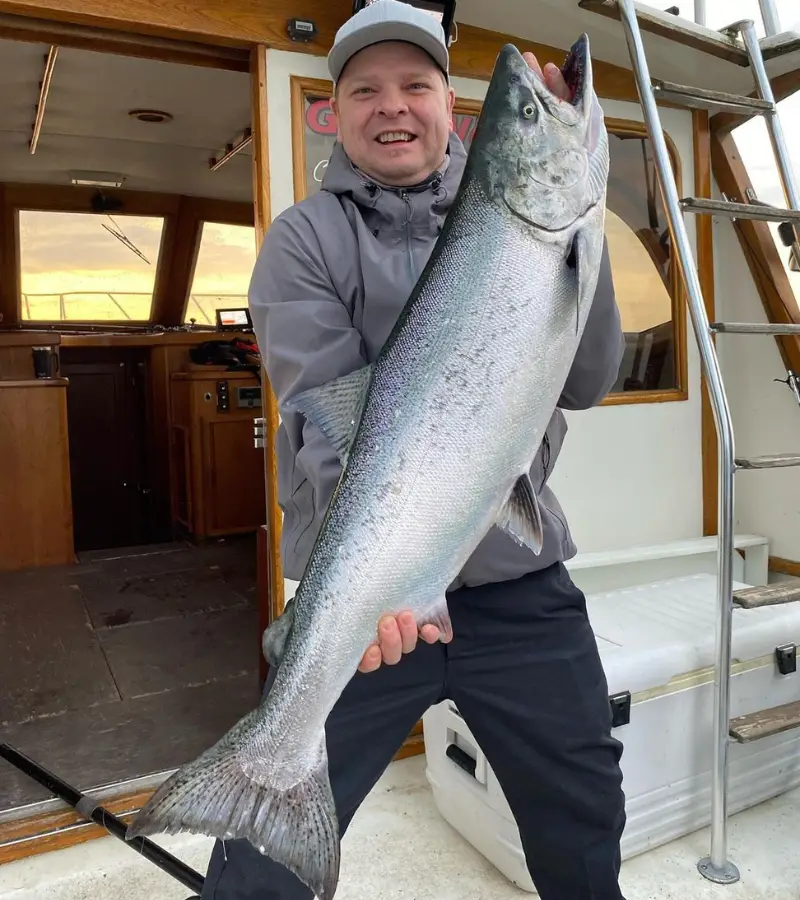Meat Rig for Salmon (Setup & How-to Guide with Pictures)
UPDATED 10 SEPTEMBER 2023
by Robert Ceran
Are you planning to use a meat rig for salmon trolling, but aren’t sure how to set it up, or how to troll it for the best results?
While the meat rig is a tried and tested setup for salmon trolling, and has been catching fish for many years, it can be challenging to set up properly and fish correctly.
In this article I’ll walk you through how to set up a meat rig, and will also discuss how to fish it to put more salmon in the boat.

What is a salmon meat rig (and what is it good for)?
A meat rig is a setup that combines a plastic head with a trailing hook, which is baited with a herring strip and used for salmon trolling. It is most commonly used for chinook and coho salmon in the great lakes, and is usually trolled behind a flasher and a downrigger.

The great thing about using a meat rig is that it combines the advantages of an artificial lure with natural bait, and this triggers salmon bites more effectively, as the herring strip releases scents into the water that are enticing to hungry salmon.
There are actually several variants of the meat rig, and in the traditional setup, two hooks are rigged in tandem, and used to hook a whole baitfish or cut plug herring at the front and the back.
We’ll cover both of these versions in more detail below.
Components needed for meat rig setup
You’ll need the following tackle components to set up a meat rig for trolling:
- Bait head
- Herring filets in brine
- 20 to 30 lb test fluorocarbon leader line
- 2 size 2 straight shank hooks (either single or treble)
Note that there are two main ways to tie a meat rig, and the most popular of these is with pre-rigged bait heads that have one (or two) trailing treble hooks.
But we’ll also show you how to set up this rig with a tandem hook array, which is the traditional way of doing it.
How to set up a meat rig

Method 1: If you’re using plastic bait heads (such as the diabolical meat rig), all you have to do is cut your herring strips down to the correct size so that they fit inside the slot at the front of the bait head.
Once you slide the herring strip into the bait head, fix it in position by poking a toothpick through the hole in the head, and then cutting off the protruding ends. You can either leave the treble hook dangling free, or you can poke it through the herring strip to further fix it in place.
Method 2: Set up a tandem hook rig with a 2 hook snell knot, and choose the spacing between your hooks so that the front and back hook correspond to the head and tail region of your bait. This tandem hook setup is also used for the mooching rig for salmon.
You can also use an adjustable 2 hook knot, which is harder to tie, but which allows you to move your hooks to fit the size of your bait. Next, tie the other end of your leader to a swivel or snap swivel, which you can attach to your main line (or to your flasher rig for trolling).
No matter which version of the meat rig you use, it’s important to make sure that your whole herring or plug cut herring spins in a tight spiral when pulled through the water. If it spins in a wide spiral instead, this doesn’t appeal to the salmon, and you’ll get much fewer bites.
How to troll a meat rig for salmon
Meat rigs are most often used as part of a salmon fishing tackle setup for trolling in the great lakes.

Images source: instagram@jcgoulardfishing
Since king salmon (aka chinook) often hold in deep water in the great lakes, it’s usually best to use a downrigger to troll your rig in sufficiently deep water.
Trolling a meat rig with a flasher
Since you have to cover a lot of water in order to find salmon in the great lakes, the best way to improve your chances of success is to combine your meat rig with a flasher setup, since the spinning and whipping action of a flasher is great for attracting salmon from a wide radius around your boat.
